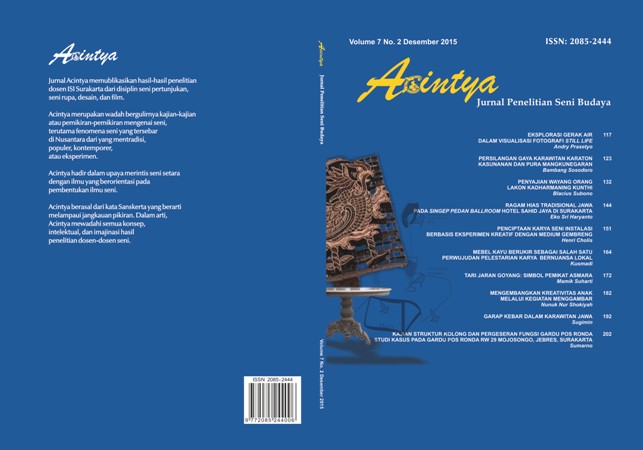MEBEL KAYU BERUKIR SEBAGAI SALAH SATU PERWUJUDAN PELESTARIAN KARYA BERNUANSA LOKAL
DOI:
https://doi.org/10.33153/acy.v7i2.2013Abstract
The carved wood furniture is a three dimension visual art work that generally uses wood material to be shaped in such a way that become a tools to support human activities. Although the furniture art work has developed for a long time, in Central Java, it only developed rapidly in the certain area as Jepara, SerenanSukoharjo, and recently, in Kalijambe, Sragen. For the reason, it becomes a chance for the writer to pay close attention to the works of the businessmen and artists in developing themselves to fulfill the consumer’sdemand. Surakarta is one of the Javanese cultural cities as well as the market area of the various product of carved wood furniture in Southern Central Java. From the shape of design produced, it can be seen that the quality is increasing in various aspects including the forms, making, ornamentation, finishing, etc. The carved wood furniture represents a support ofinterior and exterior elements and also as evaporationof the local culture identity.This research is designed to be a research that stresses on library study supported by observation on the last development of carved wood furniture forms sold in Surakarta.The result shows that the dynamic of the local
carved wood furniture is inspired by the dynamic of the wood furniture development generally. The result also becomes a material for journal writing. The result is also hoped to be an understanding base of carved wood furniture product as one effort to evaporate the local culture identity.
Keywords: wood furniture, carved, local nuance.
Downloads
References
Agus Sachari, Paradidma Desain Indonesia,
Jakarta, Rajawali, 1986.
Agus Sachari (ed), 2005. Sejarah Desain. Bandung:
Kelompok Studi Desain-Jurusan Desain
ITB.
Asmudjo Jono Irianto, 2003. Pendobrakan BatasBatas “Seni Rendah dan “Seni Tinggiâ€
dalam Paradigma dan Pasar .Yogyakarta:
Yayasan Seni Cemeti.
Edmund Burke Feldman, 1967. Art AS Image and
Idea. New Jersey: Prencict Hall., Inc.
Frank Boas, 1955. Primitive Art. New York: Dover
Publication, Inc.
Guntur, Ornamen Sebuah Pengantar, Surakarta:
P2AI& STSI Press, 2004.
H.B.Sutopo, 2002. Metode Penelitian Kualitatif:
Dasar Teori dan Terapannya dalam
Penelitian . Surakarta: UNS Press.
Inda Citranida Noerhadi, Busana Jawa Kuno, cet-
, (Jakarta: Komunitas Bambu, 2012).
Kartini Kartono, 1997. Psikhologi Umum. Bandung:
Mandar Maju.
Pramono Atmadi, Some Architectural Design
Principles of Temples in Jawa,
(Yogyakarta: Gadjah Mada University
Press,1994).
Pile, John F. 1988.Interior DesignNew York: Harry
N. Abrams, Inc.
Umar Kayam, Seni, Tradisi dan Masyarakat,
Yogyakarta, Sinar Harapan, 1981
Stepat, Dorothy, et al.,1980. Introduction to
Interior Design. New York: Macmillan
Publishing Co., Inc.
Sulasmi Darmaprawira, 2002. Warna: Teoridan
Kreativitas Penggunaannya. Bandung:
ITB.
Sunarmi, 2005. Interior Parcimayasa Karya Budaya
Mangkuenegara VII. Surakarta: UNS
Press.
Downloads
Published
How to Cite
Issue
Section
License
Copyright (c) 2017 K., Kusmadi

This work is licensed under a Creative Commons Attribution 4.0 International License.
Author continues to retain the copyright if the article is published in this journal. The publisher will only need publishing rights






